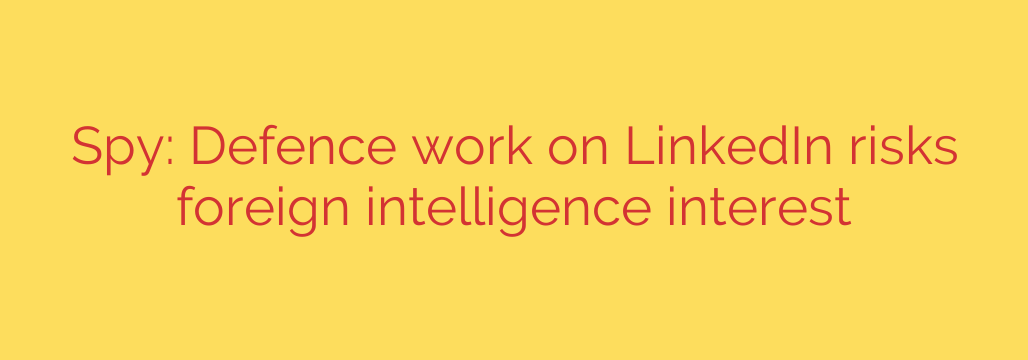
National Security Alert: How Foreign Spies Are Using LinkedIn to Target Defense Professionals
LinkedIn has become an essential tool for professional networking, career advancement, and industry collaboration. For those in the defense, intelligence, and national security sectors, it’s a powerful way to connect with peers and stay current. However, this very openness is being actively exploited by foreign intelligence services (FIS) as a primary hunting ground for valuable information and assets.
The threat is not abstract; it is a clear and present danger. Hostile state actors are systematically using professional networking sites to identify, profile, and recruit individuals with access to sensitive information. If you work in the defense industry, whether as an engineer, a project manager, a government contractor, or a researcher, you are a potential target.
Why the Defense Sector is a Prime Target
Foreign intelligence agencies are not just looking for top-secret documents. They are playing a long game, piecing together a mosaic of information from various sources. Your professional profile can provide crucial pieces of that puzzle.
Details that may seem harmless on their own can be a goldmine for a trained intelligence officer. This includes:
- Your specific job title and responsibilities.
- The names of defense projects you’ve worked on (even if unclassified).
- Your list of professional connections, which reveals team structures and hierarchies.
- Your skills and technical expertise, which can indicate specific capabilities or technologies.
By collecting this data from numerous profiles, foreign agents can map out entire supply chains, identify key personnel working on sensitive projects, and understand the capabilities and vulnerabilities of our defense infrastructure.
The Anatomy of an Attack: Common Tactics Used by Spies
The approach is often subtle and sophisticated, relying on social engineering rather than overt threats. Intelligence officers create highly convincing fake profiles, often posing as recruiters, headhunters, or fellow industry experts.
Be on the alert for these common tactics:
- Creating Convincing Fake Profiles: Agents build profiles that appear legitimate, often using stolen photos and well-written, but vague, professional histories. They may claim to work for a real, well-known company or a fabricated consulting firm with a professional-looking website.
- Dangling Lucrative Job Offers: The most common lure is a fake job opportunity that seems too good to be true. These offers often promise a significantly higher salary, a prestigious title, and exciting international travel for “consulting” work.
- Invitations to Conferences and Seminars: Another tactic is to invite a target to an all-expenses-paid conference abroad. The goal is to get the individual into a foreign environment where they are more vulnerable to being approached and recruited.
- The Slow Approach: The initial contact may be as simple as a connection request or a message complimenting your work. The agent will then engage in long-term grooming, building a rapport over weeks or months before making an overt request for information.
You Are a Target, Even If You Don’t Handle Classified Data
A critical mistake is to assume you are not a target because you don’t have a top-secret security clearance. Foreign intelligence services are intensely interested in anyone within the defense ecosystem.
This includes:
- Subcontractors and suppliers
- IT and administrative staff
- Academics and researchers at universities with defense contracts
- Former employees who still retain knowledge of projects and personnel
Seemingly minor details, such as a software platform a team uses or the name of a component supplier, can be exploited. Once a connection is made, the agent will slowly pivot the conversation toward more sensitive topics, often framing their requests as simple questions needed for a “research project” or “market analysis.”
How to Secure Your Professional Profile and Protect Yourself
Protecting yourself and your organization requires a proactive and vigilant approach to your online presence. Everyone in the defense industry shares this responsibility.
Here are actionable steps you can take today:
Sanitize Your Profile: Review your LinkedIn profile with a security mindset. Remove any overly specific details about sensitive projects, capabilities, or client relationships. Use general descriptions of your skills and experience rather than naming specific programs or technologies.
Be Skeptical of Unsolicited Contact: Scrutinize any unexpected connection requests or job offers, especially those from individuals you don’t know or that seem unusually flattering or lucrative. Ask yourself: “Why are they contacting me specifically?”
Verify Before You Connect: Before accepting a connection or responding to a message, do your own due diligence. Look for mutual connections and verify the person’s identity through their official company website. Never rely solely on the information provided in their LinkedIn profile. A quick search may reveal that their claimed company doesn’t exist or that no one by that name works there.
Limit What You Share Publicly: Adjust your privacy settings to control who can see your full profile and connection list. The less information a hostile actor can gather passively, the better.
Trust Your Instincts and Report Suspicious Activity: If a conversation feels off or an offer seems too good to be true, it probably is. Do not engage further. Report the suspicious profile to LinkedIn and, most importantly, to your company’s security officer or your relevant government security agency. You are not being paranoid; you are being professional.
The front line of national security is no longer just on the battlefield; it’s also on our screens. By maintaining digital vigilance and treating our professional profiles with the seriousness they deserve, we can help protect ourselves, our organizations, and our national security from those who seek to do us harm.
Source: https://go.theregister.com/feed/www.theregister.com/2025/08/01/asio_espionage_social_media_warning/








